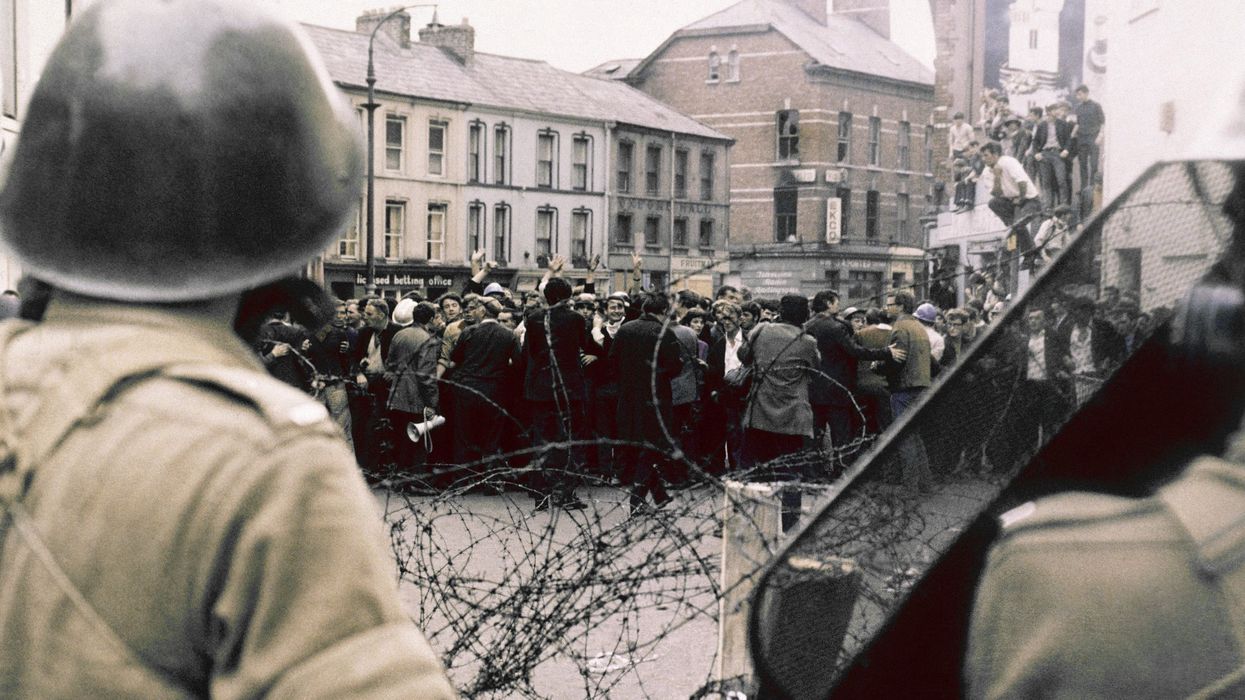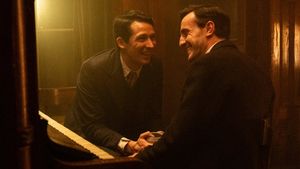A lot has changed since 1998, when the deal was reached, but the accord lives large in the imaginations of European and American citizens as a masterstroke of international cooperation that at one time seemed impossible.
What were the Troubles in Northern Ireland?
The Troubles is the term used to describe sectarian violence that took place in Northern Ireland, which led to more than 3,500 deaths and even more casualties. Horrific terrorist attacks were carried out by members of paramilitary organizations, as were acts of brutality by police and army officers.
Conflict between Republicans (supporters of a united Ireland, who were from largely Catholic communities) and Unionists (Protestants who were loyal to the United Kingdom) had existed for centuries. But it was the 1921 partition of Ireland — which created Northern Ireland — that some see as a major turning point.
The new UK province contained six of Ireland's 32 counties. By design, Northern Ireland was home to a majority of Unionists. This created huge anger among Northern Irish Republicans, who felt they were now a minority in their own country.
The exact catalyst for the Troubles is a matter of opinion. Ulster University lists the death of Francis McCloskey, a 67-year-old Republican Catholic, a day after being hit by a police baton in a protest, as the first death in the Troubles, though even the circumstances of his death are disputed. He died on July 14, 1969.
From this date, the list of violent incidents escalates. Some attacks were carried out by Unionist paramilitary groups. Some were carried out by police or army officers on protesters, like the infamous "Bloody Sunday" killings in 1972, in which 14 people were shot during a civil rights protest. Some were bombings carried out by Republican paramilitary groups, including the Provisional Irish Republican Army (IRA).
The IRA is probably the best known paramilitary group of the Troubles because of the scale of its attacks, two of which struck at the heart of the British establishment.
In 1979, an IRA volunteer assassinated Lord Louis Mountbatten, a member of the royal family who mentored the now King Charles. In 1984, the group bombed a hotel in which then-British Prime Minister Margaret Thatcher was staying, killing members of her governing Conservative Party.
Former IRA members justify their previous extreme actions by claiming there was no alternative. "War is a terrible thing. It is how you get out of it and make peace that is important. There was an alternative to conflict, that was democracy, but it did not exist," Martina Anderson, a former IRA volunteer, tells CNN.
Anderson was sentenced to life in prison in 1986, convicted of conspiring to cause explosions. She was released, along with many others, under the terms of the GFA and went on to become an elected politician for Sinn Fein, once closely associated with the IRA and now the largest political party in Northern Ireland.
The Troubles created in total 1,971 political prisoners: 1,874 were Republican, while 107 were Unionist, according to Ulster University.
Nineteen-eighty-six was also the year that saw one of the most significant political breakthroughs in the Northern Irish peace process. In September of that year, Gerry Adams, president of Sinn Fein when the party still had ties to the IRA, and John Hume, leader of the more mainstream Republican party, the Social Democratic and Labour Party (SDLP) met in secret.
The two were bitter political rivals, but their first meeting of many paved the way to IRA ceasefires that created space in the 1990s for negotiations that would lead to the GFA.
How did the Good Friday Agreement get done?
The late 1980s and 1990s saw increased willingness from all sides to end the violence and find some sort of negotiated peace. Numerous IRA ceasefires were put in place, only to be broken when it was decided by the IRA that the British government was negotiating in bad faith. But progress continued.
The major turning point came in 1997, when new leaders with the energy and mandate to push through a peace deal were elected in both Ireland and the UK. Bertie Ahern was the new leader of a minority coalition in Ireland, while the Labour Party's Tony Blair had secured a majority of 179 seats in the UK parliament. Along with the boost of US President Bill Clinton's support, the conditions for reaching an agreement were now in place.
"There was a real sense of, if we don't do it now, the moment could slip away," says Paul Bew, who advised the Unionist leader of the time, David Trimble of the Ulster Unionist Party, during the GFA negotiations. "Everyone was focused on immediate peace and stability, not long-term politics. That meant the deal wasn't perfect, but it did bring stability," Bew adds.
The main sticking points now were how to placate the parties on the extreme fringes of the debate. Sinn Fein, which was in contact with the IRA during negotiations, had pushed for two major things: kicking the IRA's decommissioning of weapons into the long grass, something that could be a gradual rather than immediate process. The party also wanted Republicans they viewed as prisoners of war to be released.
The Democratic Unionist Party ended up not supporting the deal over the disarmament issue — which resulted in Sinn Fein getting a lot of what it wanted in the final deal.
However, because the deal was widely backed among both politicians and the public in Northern Ireland and the Republic of Ireland, the DUP's support was ultimately not required. On April 10, 1998, after months of negotiations where no outcome was certain, it was announced that a deal had been done.
Alastair Campbell, a close adviser to Blair at the time, remembers the final few hours of negotiations as "magical."
"For days the sense of history was building. Either something very good or very bad was going to happen. Then everything started coming together. I think tiredness and a lack of food was a factor. But mostly it was the group of people who wanted to get it done."
Bew also points to tiredness as a major factor in how negotiations ended. "In the final few hours, I saw one man walk into a wall. He looked at the wall like it had punched him."
What is in the Good Friday Agreement?
The agreement acknowledges that in Northern Ireland, there is a majority of people who want to remain part of the UK; however, a substantial minority supports a united Ireland. It also acknowledges that on the island of Ireland as a whole, there is a majority that wants to unite Ireland. The agreement recognizes all of these opinions as valid.
The political solution proposed in the agreement is that Northern Ireland has a devolved government that must comprise both Unionists and Republicans on a power-sharing basis.
It acknowledges that Northern Ireland is part of the UK, but also gives citizens the flexibility of being able to identify fully as Irish or British.
A crucial part of the deal focuses exclusively on North-South relations. While the deal doesn't mention anything specific about an open border, it clearly encourages a situation where as little friction as possible exists on the land border between Northern Ireland and the Republic of Ireland. This would later become incredibly complicated because of Brexit, the UK's departure from the European Union.
The agreement has sections on the decommissioning of weapons and broader security concerns. The language used in the agreement is often described as "constructive ambiguity" that allowed the issue to be drawn out, in order to keep Sinn Fein happy and ensure the IRA abided by the ceasefire. The Unionist side also agreed to the release of a large number of Republicans from prison.
How is the agreement holding up and has Brexit had a negative impact?
That depends on who you ask. Most who were involved in the talks and lived through the Troubles will tell you that despite current problems — most notably the devolved Northern Ireland assembly, often referred to as Stormont, not sitting since last year because the DUP will not enter power-sharing — the situation is still vastly better than it was during the Troubles.
Norman Baxter, a retired senior police officer in Northern Ireland, points to the decline of paramilitary groups as a key area of success.
"Attacks still happen, but they really have been reduced to small groups of effectively organized crime gangs. They don't have anything like the weapons or reach that the IRA did. Nor do they have a coherent ideology. They might still be active, but the idea they could carry out anything on the scale of the worst days is just unimaginable now," he says.
On the Republican side, Anderson, the former IRA volunteer-turned Sinn Fein politician, says: "We were born into a state that didn't want us and we had no civil rights, no equality, no human rights, no democratic and peaceful path to self-determination. We have now."
However, the political situation has dramatically changed since 1998 in ways that the peace deal couldn't have predicted.
The then fringe groups, the DUP and Sinn Fein, are now the largest parties from the two communities. Their distaste for one another is no longer deadly, but it's very real.
Brexit has undeniably complicated and aggravated the animosity. Something that seriously helped the GFA stand up was the fact that both countries were in the EU's regulatory sphere. This might sound trivial, but it meant there was no need to check people or goods traveling between the two, reducing the potential for hostility.
The need to avoid any hard border between the two has been one of the thorniest areas of negotiation between the EU and the UK. Both sides ultimately decided and agreed that no hard border could exist. That has left the DUP furious and feeling sold out by the UK government, on the grounds that the result has been an effective border in the North Sea, between Northern Ireland and Great Britain. Meanwhile, many on the Republican and Sinn Fein side feel that they have had their EU membership ripped from them against their will.
As Anderson puts it: "We relied on the EU for our rights within Northern Ireland. We voted to remain."
But Brexit is far from the only things souring relations between Unionist and Republican communities.
"The biggest risk to the agreement at the moment is not likely to come in any big bang, dramatic form but more as a drip-drip erosion," says Katy Hayward, an expert in Brexit and Northern Ireland at Queen's University Belfast.
"The stasis of government not sitting and the vacuum it creates in political leadership are not cost- or consequence-free. This is particularly true in Northern Ireland, where the democratic institutions were established as the alternative to the use of violence for political means."
Why does America care so much?
Aside from the fact that Bill Clinton chaired the negotiations, the GFA has enjoyed largely bipartisan support in the US for decades. Irish identity is still strong in the US and Irish diplomats have a reputation for using international affection for Ireland to punch well above their weight.
Biden, who identifies as an Irish American, has repeatedly said that there is no alternative to the GFA and that Brexit must not be allowed to undermine peace.
What does the future hold?
Things are not perfect in Northern Ireland and it is not clear what future awaits the citizens of the province. A generation has now grown up with the agreement in place. The danger those on all sides of the argument perceive is that people forget that peace is not inevitable. Of course, things are better than they were during the Troubles. But Northern Irish politics have undeniably changed.
Everyone who spoke to CNN for this article made this point at various points in their interviews: It was never a sure thing that the GFA would be agreed, and it was never certain that it would stick in place. Vague wordings on decommissioning weapons and deliberately ambiguous interpretations are possible when there is good faith on both sides. But it is simply a fact that there is less good will in Northern Irish and British politics than there was in 1998.
The-CNN-Wire
™ & © 2023 Cable News Network, Inc., a Warner Bros. Discovery Company. All rights reserved.

















































